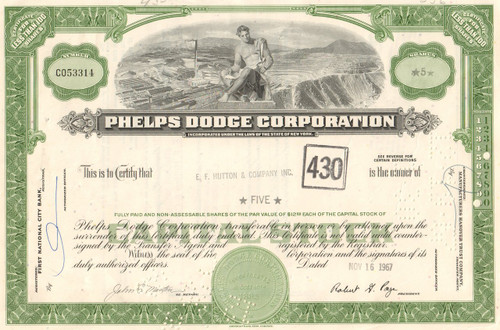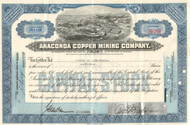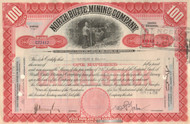Categories
Categories
- Home
- Mining and Oil
- Mining
- Phelps Dodge Corporation 1967 (copper mining)
Phelps Dodge Corporation 1967 (copper mining)
Product Description
Phelps Dodge Corporation stock certificate 1967 (copper mining)
Great copper mining stock cert with a vignette of a classical male figure in front of surface mining and refining scenes, Issued and cancelled. Dated 1967.
Phelps Dodge Corporation was an American mining company founded in 1834 as an import-export firm by Anson Greene Phelps and his two British sons-in-law William Earle Dodge, Sr. and Daniel James. The latter two ran Phelp, James & Co., the part of the organization based in Liverpool, England. The import-export firm at first exported United States cotton from the Deep South to England, and imported various metals to the US needed for industrialization. With the expansion of the western frontier in North America, the corporation acquired mines and mining companies, including the large Copper Queen Mine in Arizona. It operated its own mines and acquired railroads to carry its products. By the late 19th century, it was known as a mining company. On March 19, 2007, it was acquired by Freeport-McMoRan and now operates under the name Freeport-McMoRan Copper & Gold Inc.
Initially, Phelps Dodge operated an import-export trade business that shipped U.S.-grown cotton from the Deep South to England, importing tin, iron, copper and other metals essential for industrial growth and development in the United States.
As time went on, the company began its own mining operations in the western United States as its frontier moved west. Extensive mineral wealth, especially copper, began to be discovered and exploited. Among the properties acquired by the company was the Copper Queen Mine in Bisbee, Arizona, considered the most productive in the state in the early 20th century.
The company focused largely on providing copper wire and cables to industry, products that were in high demand as the Industrial Revolution took hold. As the company diversified, it began investing in new railroads, essential in the company’s efforts to become established in the West, especially copper-rich Arizona. It used its own lines to transport products to and from its markets on the eastern/northeastern shores.
In 1895, the first business contract was signed by Phelps Dodge Corporation and the Nichols Copper Company (which was renamed from G. H. Nichols and Company in 1891) to have Phelps Dodge deliver a minimum of 1,000,000 pounds of blister copper over three years. This economically symbiotic relationship lasted until 1922, in which Phelps Dodge provided 90% of the blister copper; Nichols Copper Company used to produce 100% pure copper.
During the late 19th century, in concert with its metal interests, Phelps Dodge Corporation became one of the largest producers of lumber and lumber products in the United States.
In Tombstone, Arizona during 1900 E. B. Gage, Frank Murphy, and William Staunton consolidated their various mining properties into a single entity, the Tombstone Consolidated Mines Company. They worked to drain mines that had filled with water, laid a rail spur into town, and revived mining. They experienced some success until the pumps failed in 1909. The new company filed for bankruptcy and the Phelps-Dodge Corporation acquired its claims.
During the 1920s, Phelps Dodge invested $3.5 million in the Nichols Copper Company's plant modernization projects in exchange for stock in Nichols Copper Company.[2] This dramatically increased copper production of the plant. In 1930, Dr. William Henry Nichols died; Phelps Dodge purchased the Laurel Hill plant that same year.
The company became notorious for its anti-union tactics, primarily for the 1917 Bisbee Deportation. The company worked with a local group of private citizens and the county sheriff to deputize about 2,000 members of a posse. Given names of IWW members and other miners, they arrested nearly 1,300 striking miners at gunpoint in Bisbee, Arizona at the Copper Queen Mine. Portraying the Wobblie miners as bent on war-related sabotage, the company ordered them expelled from the jurisdiction, deporting them to Hermanas, New Mexico. Its officials police seized telegraph and telephone lines to keep news of this from getting out.
In South America, the company had several very large copper mining operations in Peru. In the Congo, Phelps Dodge Corporation was the majority owner and operator of the Tenke Fungurume project, generally considered to be the world's largest undeveloped copper/cobalt project.
A subsidiary of Phelps Dodge Corporation, Climax Molybdenum, is the largest primary producer of molybdenum in the world. At the Henderson mine west of Empire, Colorado, Climax Molybdenum has produced more than 160 million tons of ore and 770 million pounds of molybdenum since the mine opened in 1976. Climax Molybdenum also owns the inactive Climax molybdenum mine, north of Leadville, Colorado.
The historic Phelps Dodge General Office Building in Bisbee, Arizona was declared a National Historic Landmark of the U.S. in 1983. The Phelps Dodge copper mine at Morenci, Arizona was the site of a violent strike from 1983 to 1986, culminating in one of the largest union de-certifications in American labor history. The company employed more than 13,500 people worldwide.
On Sunday, November 19, 2006, Freeport-McMoRan announced that it planned to acquire Phelps Dodge for $25.9 billion in cash and stock to create the world's largest publicly traded copper mining company. Stockholders for both companies voted on the proposal March 14, 2007. On Monday, March 19, 2007, Phelps Dodge Corporation was acquired by Freeport-McMoRan (FCX), creating the world's largest publicly traded copper company, with 25,000 employees at acquisition.
At the time of its acquisition in 2007, Phelps Dodge Corporation had large copper mining operations in Bagdad, Arizona, Morenci, Arizona, Sahuarita, Arizona, Miami, Arizona, and Tyrone, New Mexico, and the El Chino Mine in New Mexico. Several of these locations provide ores rich in molybdenum as well. It had recently begun development of the Safford Mine near Safford, Arizona. In 2006, revenue was $11.910 billion USD, operating income was $4.226 billion, and net income was $3.017 billion.
 Loading... Please wait...
Loading... Please wait... 








